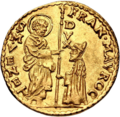Soldo
Patriarchate of Aquileia issued during the reign of Louis of Teck
(1412–1420).The soldo was an Italian medieval silver coin, issued for the first time in the late 12th century at Milan by Emperor Henry VI.[1] The name derives from the late Roman coin solidus.[2]
History
It quickly became widespread in Italy, where it was coined in
denari.[3]
As time passed, the soldo started to be coined in billon and, from the 18th century, in copper. During the reign of Leopoldo II of Tuscany (19th century), it was worth three quattrini. The Napoleonic reformation of Italian coinage (early 19th century) made it worth 5 cents, while 20 soldi were needed to form a lira.
The term, used in medieval times to designate the pay of soldiers, became its synonym in both Italian and German (as Sold).
See also
References
- ISBN 978-0-19-870474-4.
- ^ "Soldo". Merriam-Webster.
- ISBN 978-1-135-94880-1.
External links
 Media related to Soldo at Wikimedia Commons
Media related to Soldo at Wikimedia Commons

